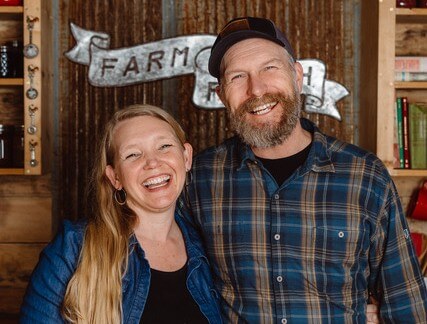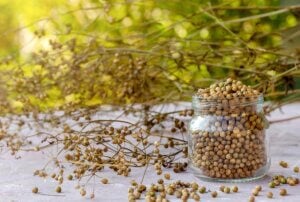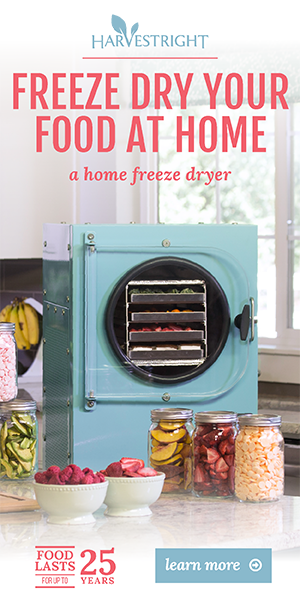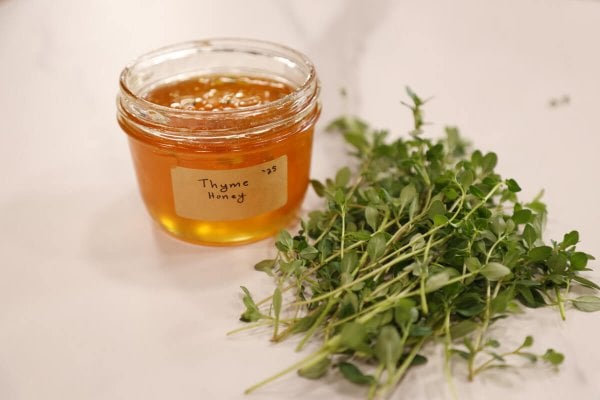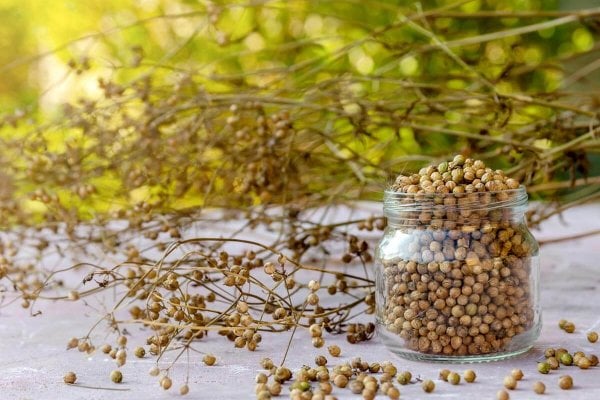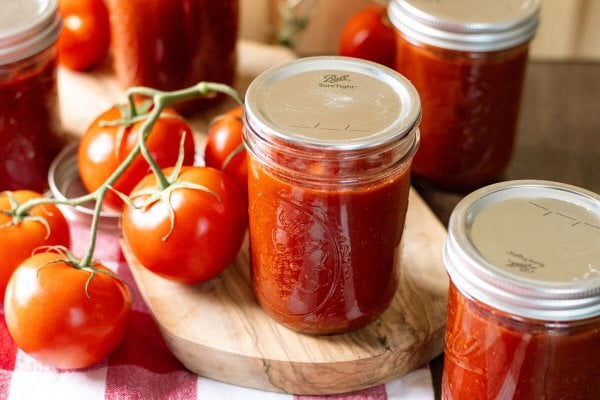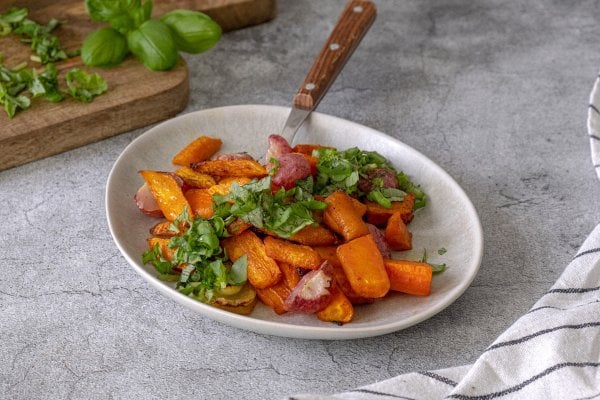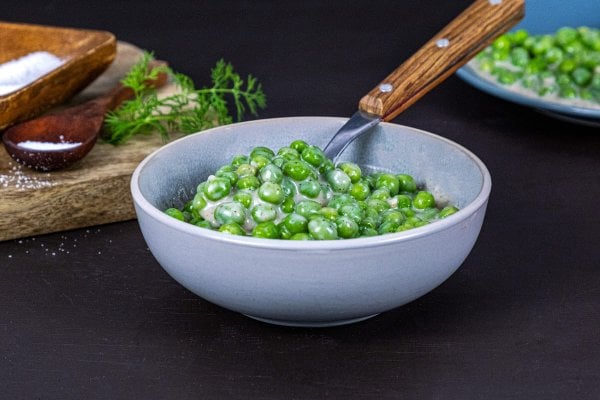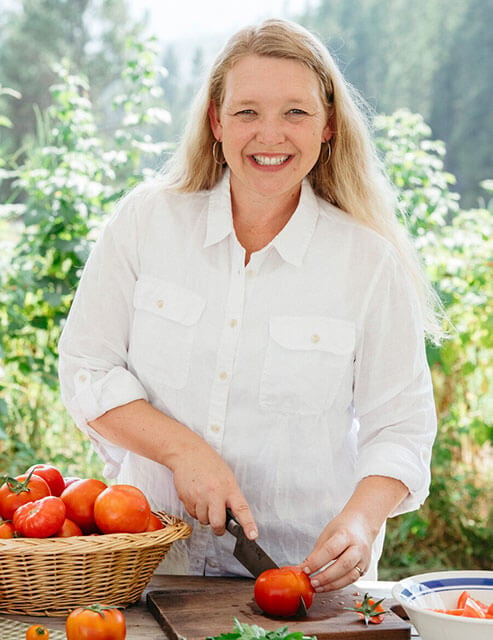Introducing easy green fermented hot sauce that will add a homemade, zesty kick to your meals. Get ready to ignite your taste buds with this flavorful condiment, then be sure to check out our fermented asparagus relish!

Did you know that over 2 billion pounds of hot peppers are consumed in the United States each year? It’s no secret that Americans love their spicy food. If you’re a fan of heat and want to explore the world of fermented condiments, then I have a treat for you.
Table of Contents
ToggleWhy I Love Fermented Hot Sauce
I love using what we have to make something delicious. Here in North Idaho, we generally have many green tomatoes left on the vine when the threat of the first frost comes. Therefore, we harvest before the frost and ripen our green tomatoes inside.
But I always save some of the green tomatoes left to make green tomato salsa and this fermented hot sauce recipe. Use green tomatoes to make this tasty hot sauce, as hot or mild as the peppers you choose.
This hot sauce will add a dash of flavor to tacos, burritos, scrambled eggs… anything! Choose perfect green tomatoes with no spots, mold, or bruises and don’t pick tomatoes from frost-killed vines.
Be sure to check out some of our other homemade condiments, like this fermented ketchup, fermented Sriracha, homemade mustard, or this fail-proof lacto-fermented mayonnaise.
What Is Fermented Hot Sauce
Fermented hot sauce is made through a process called lacto-fermentation, where beneficial bacteria called lactobacillus convert sugars in the tomatoes and peppers into lactic acid. This natural fermentation process results in a tangy, slightly sour taste with a depth of flavor that regular hot sauce lacks.
Another key difference between fermented hot sauce and regular hot sauce is the level of heat. Fermentation can mellow out the spiciness of the peppers, resulting in a more balanced and enjoyable flavor. This makes fermented hot sauce a great option for those who enjoy a milder heat level.

Benefits of Fermented Hot Sauce
There are several benefits to choosing fermented hot sauce over regular hot sauce. The fermentation process not only enhances the flavor but also increases the nutritional value of the peppers. During fermentation, the lactobacillus bacteria produce enzymes, vitamins, and probiotics, making fermented hot sauce a healthier choice.
Additionally, fermented hot sauce is known for its longer shelf life compared to regular hot sauce. The acidity created during fermentation acts as a natural preservative, allowing the hot sauce to be stored for a longer period without the need for refrigeration.
| Fermented Hot Sauce | Regular Hot Sauce |
|---|---|
| Flavorful and tangy taste | Standard heat and flavor |
| Enhanced nutritional value | Less nutritional benefits |
| Milder heat level | Potentially spicier |
| Longer shelf life | Shorter shelf life |

Tips for Perfect Fermented Hot Sauce
Creating the perfect fermented hot sauce requires attention to detail and a few essential tips. Whether you’re a beginner or an experienced fermenter, these guidelines will help you achieve outstanding flavor and quality:
- Select the Right Peppers – Choose fresh, high-quality peppers for your hot sauce. Opt for a combination of hot peppers like chili pepper, jalapeno, or habanero to create a well-rounded flavor profile. The variety of peppers you use will determine the heat level and complexity of your sauce.
- Protect Your Hands – Handle hot peppers carefully, and consider wearing gloves to protect your hands from their heat.
- Adjust the Heat – Remove the seeds of the peppers if you prefer a milder hot sauce.
- Understand the Fermentation Process – The fermentation process is key to developing the unique flavors of your hot sauce. Lacto fermentation is the foundation of this process. Be patient and allow the natural fermentation to take place, as this will enhance the taste and quality of your sauce.
- Use the Right Fermentation Vessels – Choose fermentation vessels that are suitable for the job, such as Mason jars, fermentation crocks or a glass airlock crock. These vessels provide the ideal environment for the fermentation process, allowing carbon dioxide to escape while preventing oxygen from entering.
- Use Proper Fermentation Weight – During the fermentation process, it’s crucial to keep your peppers submerged in the brine to prevent spoilage. Use fermentation weights or wooden skewers to hold the peppers down and ensure they stay fully immersed in the brine. This helps create a safe and controlled environment for fermentation.
- Allow Sufficient Fermentation Time – Give your hot sauce ample time to ferment and develop its unique flavors. The duration of fermentation can vary depending on factors such as temperature and pepper type. Generally, a fermentation period of 4 to 6 weeks at room temperature will yield the best results.
- Properly Store Your Fermented Hot Sauce – Once your hot sauce has reached its desired flavor profile, strain the ingredients from the brine, blend or puree with an immersion blender, then transfer it to airtight bottles or jars and store them in the refrigerator. When properly stored, fermented hot sauce can last for several months. Feel free to experiment and enjoy the tangy, spicy kick it adds to your favorite dishes!

Does Adding Vinegar to Hot Sauce Stop Fermentation?
One common question that arises when making fermented hot sauce is whether the addition of vinegar can halt the fermentation process. It’s important to clarify this misconception and understand how vinegar can affect the fermentation of your hot sauce.
When making fermented hot sauce, the primary agent for fermentation is the naturally occurring lactic acid bacteria found on the peppers. These bacteria convert the sugars in the peppers into lactic acid, giving the hot sauce its tangy flavor.
Vinegar, on the other hand, is a result of a separate fermentation process. If you add vinegar to your hot sauce during the fermentation, it can affect the overall microbial balance. Vinegar has a high acidity level which can inhibit the growth of lactic acid bacteria and slow down the fermentation process.
While the addition of vinegar can halt the fermentation to some extent, it does not completely stop it. The lactic acid bacteria may continue to ferment at a slower rate, albeit at a diminished level. This can result in a milder ferment with less tangy flavor compared to a hot sauce without vinegar added during the fermentation.
If you prefer a more pronounced tangy flavor, it’s best to avoid adding vinegar during the fermentation and let the lactic acid bacteria do their work. However, if you prefer a milder flavor profile, you can incorporate vinegar into your hot sauce recipe after the initial fermentation process is complete.

The Homestead Kitchen
This recipe for green fermented hot sauce was featured in issue No.14 of the Homestead Kitchen magazine. If you desire a life of self-reliance but find yourself scrolling through social media, watching the lives of others who are fulfilling YOUR dream, then this magazine was designed just for you.
Our goal as established homesteaders is to share all we have learned, both the good and bad, to support you and help you build the confidence you need to chase your homesteading dreams.
Enter the Homestead Kitchen magazine. This beautiful, well-designed magazine, curated with homesteading information like recipes, DIY instructions, tips and tricks, and easy-to-follow guides, will save you time and headaches on your homesteading journey.
The response has been so great that this magazine is now available in print! So subscribe today to have your monthly copy delivered right to your mailbox.

Supplies Needed
Before you embark on making your own delicious fermented hot sauce, it’s important to have all the necessary supplies at hand:
- Broiler Pan – This recipe roasts green tomatoes, giving it a flavor that sets it apart from other fermented hot sauce recipes.
- Quart Jars & Lids – Azure Standard and Lehman’s are both great sources for canning supplies. Homesteading Hack: If you’re a first-time Azure Standard customer, use coupon code “HOMESTEADINGFAMILY15” at checkout for 15% off your order of $100 or more!
- Fermentation Weights – I love these fermentation weights, but you can also use two bamboo skewers to keep the ingredients submerged under your brine.
- Waterproof Tray – A dinner plate works great. This is in case any of the brine spills over the top of the jar (which is known to happen during fermentation).
- Tea Towel – If you don’t have a dark place to keep your jars during the fermentation process, you can cover them with a clean tea towel.
- Blender – A high-powered blender works great if you prefer a smooth consistency for your hot sauce. Otherwise, an immersion blender works well, too.
- Bottles – Flip-top glass bottles with narrow necks are great for your finished sauce, but glass Mason jars work for storage, too.

Ingredients Needed
By combining the following ingredients, you can create a fermented hot sauce that will add a kick to your meals. Experiment with different pepper varieties and ratios to find the perfect blend that suits your taste buds.
- Green Tomatoes – If you don’t have six large green tomotoes, you can use an equivalent amount of small ones.
- Anaheim Peppers – Other peppers such as bell, poblano, or cubanelle peppers can also be used.
- Serrano Peppers – Other peppers such as banana, cayenne, or jalapeno peppers can also be used.
- Onion – Learn how to grow onions from seed here!
- Head of Garlic – 5-6 teaspoons of freeze-dried garlic can also be used. Learn to grow garlic from seed here.
- Cool Water – When making ferments, always use unchlorinated water.
- Salt – My favorite is Redmond Real Salt (use code “HFSalt” at checkout to get 15% off your order).



How to Make Fermented Hot Sauce
- Preheat the broiler with a rack on the upper shelf.
- Wash the jars and lids in hot, soapy water and let air dry.
- Wash the tomatoes and peppers.
- Snap the stems off the tomatoes, but do not cut them.
- Place tomatoes on a broiler pan and roast them, turning until black patches appear on all sides. Let the tomatoes cool.
- Meanwhile, stem the peppers, peel and chop the onions and garlic.
- Mix the salt with water (brine) and set aside to dissolve, stirring occasionally, if needed.
- Pack the cooled tomatoes, peppers, onions, and garlic in the jars, dividing evenly and leaving 1 1⁄2 – 2 inches (4-5 cm) headspace. You can rub the blackened skin off the tomatoes, if desired, or leave it on for flavor.
- Pour the brine into the jars, leaving 1 1⁄2 – 2 inches (4-5 cm) headspace while covering the ingredients completely.
- Add weights or break bamboo skewers into lengths to fit crisscross inside the neck of the jar to hold down the ingredients. It’s important that the vegetables stay completely submerged in the brine or you may get mold formation. Add lids to jars.
- Set the jars on a waterproof tray or plate in a spot that stays between 60-75°F (16-24°C). It should not be exposed to direct sunlight, so if it is on your counter, cover it with a dish towel.
- Let it ferment for 4-6 weeks. Burp the jar as needed when pressure builds, but don’t open the jar unnecessarily as tomatoes and peppers are prone to mold and this will encourage mold.
- After fermenting, drain the brine (reserving it for later) and transfer the fermented vegetables to a blender.
- Puree it smooth, or leave it a bit chunky. Add as much brine as needed to reach the consistency you like. It’s your sauce; you can make it just the way you like it!
- Pour the finished sauce into bottles (saved from store purchases) and refrigerate for up to a year. If it develops mold, it should be discarded.



Now that you have your finished fermented hot sauce, it’s time to put it to use in your cooking. Add a few drops to marinades, dressings, or stir it into your favorite recipes to give them a spicy kick. The heat level, combined with the complex flavors, will undoubtedly elevate your culinary creations to new heights.
Did you make this recipe? If so, please leave a star rating in the recipe card below. Then, snap a photo and tag us on social media @homesteadingfamily to show us your fermented hot sauce!

FAQ
Fermented hot sauce is a condiment made through the process of lacto fermentation, where hot peppers are submerged in a brine and left to ferment at room temperature. This fermentation process creates a tangy, zesty flavor profile.
The main difference lies in the fermentation process. Fermented hot sauce undergoes a period of fermentation, which adds depth of flavor, tartness, and complexity compared to regular hot sauce that is typically made with vinegar. Fermented hot sauce also often has a smoother, more rounded heat.
The duration of fermentation depends on personal taste preferences and the desired level of fermentation. Generally, fermenting hot sauce for about 4 to 6 weeks at room temperature allows the flavors to develop fully. It is important to monitor the sauce and taste it periodically to determine when it has reached the desired tanginess and flavor.
Adding vinegar to hot sauce will not necessarily stop the fermentation process completely. However, the addition of vinegar can slow down the fermentation by lowering the pH level, which inhibits the growth of bacteria. If you prefer to halt the fermentation process, refrigerate the hot sauce after adding vinegar.

Other Posts You May Enjoy
- What is Fermentation? A Beginner’s Guide to Getting Started
- Fermentation for Long-Term Preservation
- Fermented Ketchup (Easy, Homemade, Probiotic & Kids Love It)
- Easy Homemade Lacto-Fermented Mayo
- Easy Pickled Garlic (Fermented Garlic Recipe)
- Preserving Tomatoes for Winter – Fermented Tomatoes Recipe
- Homemade Fermented Ginger Carrots
- Quick & Easy Zucchini Pickles

Green Fermented Hot Sauce
Equipment
- Broiler Pan
- 2 Quart Jars & Lids
- 2 Fermentation Weights or wooden skewers
- Waterproof Tray
- Tea Towel optional
- Blender or Stick Blender
- Bottles
Ingredients
- 6 large Green tomatoes
- 4 Anaheim peppers
- 6 Serrano peppers
- 1 Onion
- 1 whole Garlic the entire head
- 4 cups Water unchlorinated
- 3 Tablespoons Salt
Instructions
- Preheat the broiler with a rack on the upper shelf.
- Wash the jars and lids in hot, soapy water and let air dry.
- Wash the tomatoes and peppers.
- Snap the stems off the tomatoes, but do not cut them.
- Place tomatoes on a broiler pan and roast them, turning until black patches appear on all sides. Let the tomatoes cool.
- Meanwhile, stem the peppers, peel and chop the onions and garlic.
- Mix the salt with water (brine) and set aside to dissolve, stirring occasionally, if needed.
- Pack the cooled tomatoes, peppers, onions, and garlic in the jars, dividing evenly and leaving 1 1⁄2 – 2 inches (4-5 cm) headspace. You can rub the blackened skin off the tomatoes, if desired, or leave it on for flavor.
- Pour the brine into the jars, leaving 1 1⁄2 – 2 inches (4-5 cm) headspace while covering the ingredients completely.
- Add weights or break bamboo skewers into lengths to fit crisscross inside the neck of the jar to hold down the ingredients. It’s important that the vegetables stay completely submerged in the brine or you may get mold formation. Add lids to jars.
- Set the jars on a waterproof tray or plate in a spot that stays between 60-75°F (16-24°C). It should not be exposed to direct sunlight, so if it is on your counter, cover it with a dish towel.
- Let it ferment for 4-6 weeks. Burp the jar as needed when pressure builds, but don’t open the jar unnecessarily as tomatoes and peppers are prone to mold and this will encourage mold.
- After fermenting, drain the brine (reserving it for later) and transfer the fermented vegetables to a blender.
- Puree it smooth, or leave it a bit chunky. Add as much brine as needed to reach the consistency you like. It’s your sauce; you can make it just the way you like it!
- Pour the finished sauce into bottles (saved from store purchases) and refrigerate for up to a year. If it develops mold, it should be discarded.
Notes
Tips for Perfect Fermented Hot Sauce
Creating the perfect fermented hot sauce requires attention to detail and a few essential tips. Whether you’re a beginner or an experienced fermenter, these guidelines will help you achieve outstanding flavor and quality:- Select the Right Peppers – Choose fresh, high-quality peppers for your hot sauce. Opt for a combination of hot peppers like chili pepper, jalapeno, or habanero to create a well-rounded flavor profile. The variety of peppers you use will determine the heat level and complexity of your sauce.
- Protect Your Hands – Handle hot peppers carefully, and consider wearing gloves to protect your hands from their heat.
- Adjust the Heat – Remove the seeds of the peppers if you prefer a milder hot sauce.
- Understand the Fermentation Process – The fermentation process is key to developing the unique flavors of your hot sauce. Lacto fermentation is the foundation of this process. Be patient and allow the natural fermentation to take place, as this will enhance the taste and quality of your sauce.
- Use the Right Fermentation Vessels – Choose fermentation vessels that are suitable for the job, such as Mason jars, fermentation crocks or a glass airlock crock. These vessels provide the ideal environment for the fermentation process, allowing carbon dioxide to escape while preventing oxygen from entering.
- Use Proper Fermentation Weight – During the fermentation process, it’s crucial to keep your peppers submerged in the brine to prevent spoilage. Use fermentation weights or wooden skewers to hold the peppers down and ensure they stay fully immersed in the brine. This helps create a safe and controlled environment for fermentation.
- Allow Sufficient Fermentation Time – Give your hot sauce ample time to ferment and develop its unique flavors. The duration of fermentation can vary depending on factors such as temperature and pepper type. Generally, a fermentation period of 4 to 6 weeks at room temperature will yield the best results.
- Properly Store Your Fermented Hot Sauce – Once your hot sauce has reached its desired flavor profile, strain the ingredients from the brine, blend or puree with an immersion blender, then transfer it to airtight bottles or jars and store them in the refrigerator. When properly stored, fermented hot sauce can last for several months. Feel free to experiment and enjoy the tangy, spicy kick it adds to your favorite dishes!

